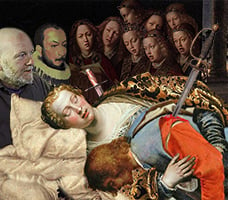
Music Director Joana Carneiro, having missed the season’s opening concert two months ago on doctor’s orders, made a welcome return to her conducting duties at the Berkeley Symphony Thursday evening. She brought a new maturity to a rendition of Brahms’ Second symphony, beguiled some listeners with an intriguing 1997 work by Australian Brett Dean, and joined San Francisco Symphony Associate Principal cellist Peter Wyrick in a straightforward account of Haydn’s C Major concerto.
The concert began with Dean’s Carlo for 15 strings, sampler, and tape, an appropriately weird excursion into the music and life of Renaissance composer and murderer Carlo Gesualdo (1566-1613). In it, the tape plays prerecorded choral excerpts from Gesualdo’s Moro lasso off and on, Dean’s strings deconstruct it, and the sampler, controlled onstage from a keyboard, triggers voices, cries, whispers, and/or dying gasps at musical cruxes. The entire 21-minute composition can be said to enact Gesualdo’s musical eccentricities, his suspicions about his wife’s unfaithfulness, his laying in wait to discover her and her lover in flagrante, his murder of them both, and his subsequent guilty thoughts about his unpunished actions.
The effect of the piece is highly unsettling, as reported to me by patrons during intermission: “Haunting,” “Irritating,” “Made my skin crawl,” “Atmospheric,” “Like The Turn of the Screw.” One listener did not care for the disembodied voices coming out of speakers: “I yearned for actual performers.”
Carlo is powerful stuff that’s best performed in a more closeted space — on Halloween. At sound-gobbling Zellerbach Auditorium, the string sound didn’t pack enough punch, while the electronic emanations from speakers were too much in the fore. Other listeners were intrigued at first, then became bored until the music heated up at the deaths about 15 minutes in. Dean would be wise to cut two minutes or so from the first half of his excellent composition. Attendees who liked what they heard should acquire the BIS recording to experience an improved balance of forces.
I love watching Peter Wyrick play at the S.F. Symphony. His heart is always in the music, and his pleasant expressions make him seem the nicest guy in Davies. He could sell me the Golden Gate Bridge. Unfortunately at Zellerbach, he could do the same only for the frisky third movement of the Haydn concerto, which he brought off with virtuoso élan. The first two movements were merely workmanlike to my ears, and suffered from occasional intonation issues.
After intermission came the redoubtably familiar Second of Brahms, which is played by at least 30 orchestras every year. I was not expecting to be surprised, but surprised I was indeed. First came this item in Thomas May’s otherwise serviceable program notes:
In recent decades, Brahms has reemerged as uniquely appealing, an antidote for an era given to postmodern ennui and somehow convinced that there’s nothing new to be said.
I must inform Mr. May that Brahms has never in my lifetime been eclipsed as a top-drawing symphonic composer, and thus has never had the opportunity to “reemerge” to an appealing status. Furthermore, May’s own program notes for the Dean work (not to mention dozens of other works) show during 1990s postmodernism there was plenty new to be said.
The second surprise was Carneiro’s handling of the Brahms. Rather than emulate tyros that try to inject life into an old masterpiece by goosing the pace, Carneiro tackled the deeper challenge of maintaining interest of jaded old critics like me at traditional tempos, and maintain she did in an admirably sculpted and balanced approach to the music. Along with fine playing by all, the Symphony’s horn section was especially to be commended.
Even though she brought murder into the sacred halls of Zellerbach, I’m grateful that Maestro Carneiro is back in business.

